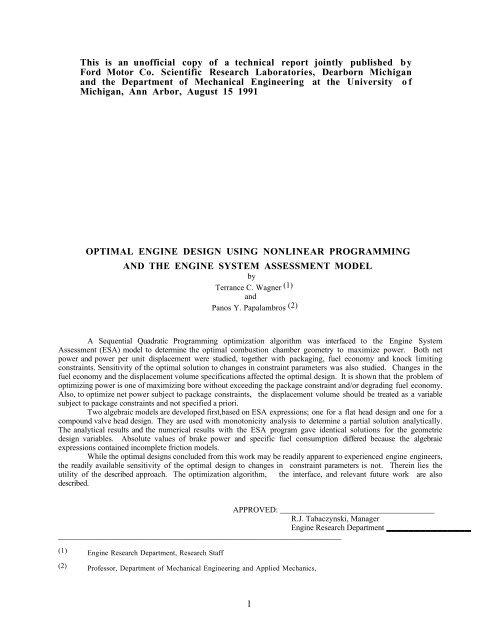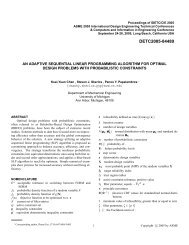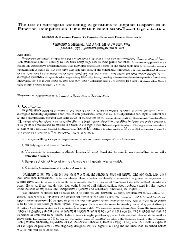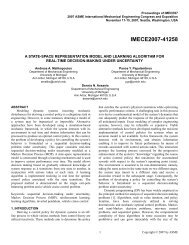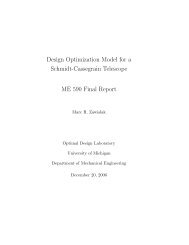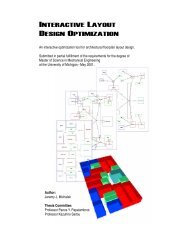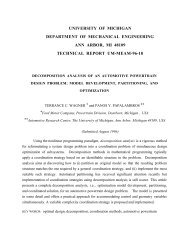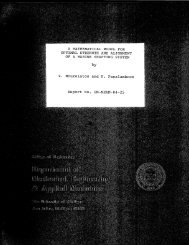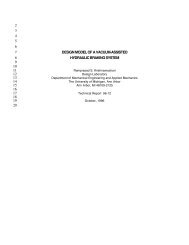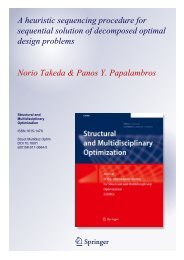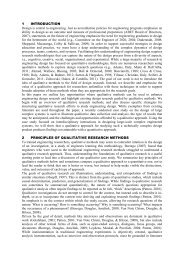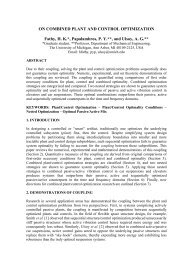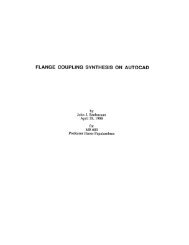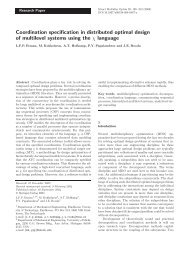Optimal Engine Design Using Nonlinear Programming and the ...
Optimal Engine Design Using Nonlinear Programming and the ...
Optimal Engine Design Using Nonlinear Programming and the ...
You also want an ePaper? Increase the reach of your titles
YUMPU automatically turns print PDFs into web optimized ePapers that Google loves.
This is an unofficial copy of a technical report jointly published byFord Motor Co. Scientific Research Laboratories, Dearborn Michigan<strong>and</strong> <strong>the</strong> Department of Mechanical <strong>Engine</strong>ering at <strong>the</strong> University o fMichigan, Ann Arbor, August 15 1991OPTIMAL ENGINE DESIGN USING NONLINEAR PROGRAMMINGAND THE ENGINE SYSTEM ASSESSMENT MODELbyTerrance C. Wagner (1)<strong>and</strong>Panos Y. Papalambros (2)A Sequential Quadratic <strong>Programming</strong> optimization algorithm was interfaced to <strong>the</strong> <strong>Engine</strong> SystemAssessment (ESA) model to determine <strong>the</strong> optimal combustion chamber geometry to maximize power. Both netpower <strong>and</strong> power per unit displacement were studied, toge<strong>the</strong>r with packaging, fuel economy <strong>and</strong> knock limitingconstraints. Sensitivity of <strong>the</strong> optimal solution to changes in constraint parameters was also studied. Changes in <strong>the</strong>fuel economy <strong>and</strong> <strong>the</strong> displacement volume specifications affected <strong>the</strong> optimal design. It is shown that <strong>the</strong> problem ofoptimizing power is one of maximizing bore without exceeding <strong>the</strong> package constraint <strong>and</strong>/or degrading fuel economy.Also, to optimize net power subject to package constraints, <strong>the</strong> displacement volume should be treated as a variablesubject to package constraints <strong>and</strong> not specified a priori.Two algebraic models are developed first,based on ESA expressions; one for a flat head design <strong>and</strong> one for acompound valve head design. They are used with monotonicity analysis to determine a partial solution analytically.The analytical results <strong>and</strong> <strong>the</strong> numerical results with <strong>the</strong> ESA program gave identical solutions for <strong>the</strong> geometricdesign variables. Absolute values of brake power <strong>and</strong> specific fuel consumption differed because <strong>the</strong> algebraicexpressions contained incomplete friction models.While <strong>the</strong> optimal designs concluded from this work may be readily apparent to experienced engine engineers,<strong>the</strong> readily available sensitivity of <strong>the</strong> optimal design to changes in constraint parameters is not. Therein lies <strong>the</strong>utility of <strong>the</strong> described approach. The optimization algorithm, <strong>the</strong> interface, <strong>and</strong> relevant future work are alsodescribed.APPROVED: ______________________________________R.J. Tabaczynski, Manager<strong>Engine</strong> Research Department______________________________________________________________________(1) <strong>Engine</strong> Research Department, Research Staff(2) Professor, Department of Mechanical <strong>Engine</strong>ering <strong>and</strong> Applied Mechanics,1
The University of Michigan, Ann Arbor, MI.2
1. Introduction<strong>Engine</strong> modeling activities at Ford have <strong>the</strong> long term goal of reducing productdevelopment time <strong>and</strong> cost <strong>and</strong> improving product value. By providing sufficiently accuratesimulations <strong>the</strong>se models enable engineers to assess <strong>the</strong> effects of engine design variables on bo<strong>the</strong>ngine commodity objectives <strong>and</strong>, with <strong>the</strong> complementary use of <strong>the</strong> Corporate VehicleSimulation Program (CVSP), <strong>the</strong> effects on vehicle objectives. Sufficiently accurate models canbe used to seek optimal designs, but to date, <strong>the</strong> methods represent an arduous task for <strong>the</strong> user.An array of design variables is usually determined by <strong>the</strong> user <strong>and</strong> a batch file is built to run <strong>the</strong>given model with this array of inputs. The output is <strong>the</strong>n regressed in terms of those variables <strong>and</strong><strong>the</strong> optimum sought by <strong>the</strong> user. (See for example, <strong>the</strong> use of Taguchi <strong>Design</strong> of Experimentstechniques by Kenney et.al. [1989].) This paper demonstrates <strong>the</strong> utility of incorporatingnumerical optimization methods into this process.Specific advantages result from such an approach. The reduction of workload in seeking<strong>the</strong> optimum is <strong>the</strong> most obvious. With <strong>the</strong> appropriate interface of a model to an optimizationsoftware package <strong>the</strong> user can readily study design solutions by changing <strong>the</strong> set of designvariables, <strong>the</strong> design objective <strong>and</strong> constraints, <strong>and</strong> examining <strong>the</strong> effects of widening ornarrowing <strong>the</strong> constraint boundaries.In this report, optimization techniques are used in internal combustion engine design toobtain preliminary values for a set of combustion chamber design variables that maximize poweroutput per unit displacement volume while meeting specific fuel economy <strong>and</strong> packagingconstraints. Two types of ma<strong>the</strong>matical optimization models are used: an explicit algebraic modelobtained by simplifying expressions found in <strong>the</strong> <strong>Engine</strong> System Assessment program [Belaire <strong>and</strong>Tabaczynski, 1985] <strong>and</strong> an optimization model which uses <strong>the</strong> <strong>Engine</strong> System Assessmentprogram directly as a function generator. Two combustion chamber geometries are studied with<strong>the</strong> algebraic model, a simple flat head design <strong>and</strong> a compound valve head design.The report is organized as follows. A brief review of <strong>the</strong> use of numerical optimizationtechniques (including applications to engine design) is provided. Next, <strong>the</strong> development of <strong>the</strong>explicit algebraic models are presented followed by some analysis on boundedness <strong>and</strong> constraintactivity. Relevant features of <strong>the</strong> ESA model are described next. Computational results are <strong>the</strong>npresented for both <strong>the</strong> algebraic models <strong>and</strong> <strong>the</strong> ESA program. Lastly, extensive parametricstudies are presented to show how changes in parameter values affect <strong>the</strong> optimal design.The work described here is preliminary. The advantages of extending <strong>the</strong>se techniques tomore detailed models like <strong>the</strong> <strong>Engine</strong> Simulator (ENGSIM) <strong>and</strong> <strong>the</strong> Corporate Vehicle SimulationProgram (CVSP) should become apparent. ESA was selected as <strong>the</strong> first model because of its ease1
of use, its explicit algebraic expressions <strong>and</strong> its continued proliferation into <strong>the</strong> companyoperations.2. Optimization MethodsThe terms objective, constraint, variable, parameter, vector, <strong>and</strong> feasible domain haveexplicit definitions given below.The objective is <strong>the</strong> quantity to be optimized (minimized or maximized). It can be anexplicit algebraic function or it can be an output of ano<strong>the</strong>r computer program .A (design)variable is any quantity allowed to vary during <strong>the</strong> search for <strong>the</strong> optimumobjective. At least <strong>the</strong> objective function or one of <strong>the</strong> constraints should depend on a variable;o<strong>the</strong>rwise it is not relevant to <strong>the</strong> problem statement.A parameter is any quantity appearing in <strong>the</strong> problem statement which is fixed during <strong>the</strong>optimization. For example, <strong>the</strong> values of <strong>the</strong> bounds appearing in <strong>the</strong> constraint set are parameters.A constraint bounds <strong>the</strong> set of variables in some way. Examples are: upper <strong>and</strong> lowerbounds on variables, equality relationships among variables, upper <strong>and</strong> lower bounds on explicitalgebraic expressions relating design variables or upper <strong>and</strong> lower bounds on outputs of a model.The set of variable values bounded by <strong>the</strong> set of constraints is called <strong>the</strong> feasible domain.A vector is simply a set of scalars. The set of variables is a vector; <strong>the</strong> set of equalityconstraints is a vector; <strong>the</strong> set of inequality constraints is a vector. Also recall from multivariablecalculus that <strong>the</strong> gradient of a scalar is a vector; <strong>and</strong> that <strong>the</strong> gradient of a vector is a matrix.2.1 Unconstrained OptimizationThe goal of optimization is to minimize or maximize a single function f, which depends onone or more independent variables. The value of those variables at that minimum or maximum <strong>and</strong><strong>the</strong> value of f is termed <strong>the</strong> optimal solution. The calculation of gradients in <strong>the</strong> design variablespace in search of a minimum is <strong>the</strong> essence of <strong>the</strong> algorithms of interest here. For acomprehensive, underst<strong>and</strong>able introduction to optimization see Chapter 10 of Numerical Recipes- The Art of Scientific Computing, [Press, et.al.,1987].The classical statement of an unconstrained optimization problem is to minimize (ormaximize) a function f which depends upon a vector, x, of n variables where x = {x 1 ,x 2 , ......,x n ,} . The statement of <strong>the</strong> problem for x is:minimize f(x)x = {x 1 ,x 2 , ......, x n ,} ε R n (1)For a single variable problem, (x = {x}) recall from calculus that <strong>the</strong> first order necessarycondition for a minimum is df/dx = 0. Also recall that <strong>the</strong> value of d 2 f/dx 2 at this value of x2
sufficiently determines whe<strong>the</strong>r <strong>the</strong> function is a minimum or maximum; it is called <strong>the</strong> secondorder sufficiency condition . Similarly, for a function of n variables <strong>the</strong> first order necessarycondition is that <strong>the</strong> gradient of f(x) be equal to zero. That is:∂ f = 0∂x 1∇f(x) = ∂ f = 0 (2)∂x 2. .. .∂ f = 0∂x nThis results in a set of n equations that must be solved. Newton's method is a straightforwardalgorithm to solve such a set of equations. The following steps describe <strong>the</strong> algorithm .Step 1.Step 2.Pick a starting point (a guess of <strong>the</strong> solution) x 0 <strong>and</strong> set an iteration counterk = 0. (Superscript indicates iteration number).Calculate a step size, d k , to move in x whered k = -[D(∇f(x) ) k ] -1 (∇f(x) ) k (3)<strong>and</strong> D(∇f(x) )is <strong>the</strong> Jacobian of <strong>the</strong> gradient of f(x) <strong>and</strong> <strong>the</strong> Hessian of f(x).Step 3.Calculate a new value of x usingx k+1 = x k + d k (4)Step 4. If a convergence criteria is satisfied (e.g. || x k+1 - x k || ≤ ε) stop;o<strong>the</strong>rwise increment k by one <strong>and</strong> go to 2.For quadratic functions, it can be shown that this method converges in one step from <strong>the</strong> startingpoint [Dennis et al., 1989].2.2 Constrained OptimizationMost design problems have many constraints imposed. For example, engine designproblems include geometric constraints on <strong>the</strong> engine package, <strong>and</strong> performance criteria constraintson <strong>the</strong> vehicle. The constraints can be in <strong>the</strong> form of an equality ( e.g., π (bore) 2 x (stroke) - 4(volume) = 0) or an inequality (e.g., (maximum piston speed) - 25m/sec ≤ 0). Each equalityconstraint equation is valued at 0 <strong>and</strong> is usually denoted by h. Similarly, inequalities are3
expressions set less than or equal to 0 <strong>and</strong> are denoted by g. Table I shows a formal statement of aconstrained minimization problem .Table 1. Example of Constrained Minimization Problemminimize f (x) (x 1 + 3x 2 +x 3 ) 2 + 4(x 1 -x 2 ) 2subject to:h1(x) = 0 1-x 1 - x 2 - x 3 = 0g1(x) ≤ 0 3 + x 13 - 4x 3 - 6x 2 ≤ 0g2(x) ≤ 0 -x 1 ≤ 0g3(x) ≤ 0 -x 2 ≤ 0g4(x) ≤ 0 -x 3 ≤ 0In shorth<strong>and</strong> <strong>the</strong> formal statement of this problem is:min f(x)subj. to : h(x) = 0 (5)g(x) ≤ 0where h(x) = {h 1 (x),h 2 (x),...,hm(x)} is a vector of equality constraints <strong>and</strong> g(x) ={g 1 (x),g 2 (x),...,g l (x )} is a vector of inequality constraints.2.2.1 The LagrangianA class of algorithms have been developed to solve this problem by minimizing a scalarfunction called <strong>the</strong> Lagrangian. It is a weighted sum of <strong>the</strong> objective function <strong>and</strong> <strong>the</strong> constraints.The weights are multipliers for each of <strong>the</strong> constraints. There are l multipliers for <strong>the</strong> equalityconstraints, λ = ( λ 1 , λ 2 ,... λ l) <strong>and</strong> m multipliers for <strong>the</strong> inequality constraints,µ = ( µ 1 , µ 2 ,... µ m ). Hence λ <strong>and</strong> µ are vectors. The Lagrangian is written asL = f(x) + ∑ l λ i h i (x) + ∑ m µ i g i (x) (6)<strong>and</strong> <strong>the</strong> optimization problem is stated asminimize L(x)subject to: µ ≥ 0 (7)λ ≠ 0.Formulation of <strong>the</strong> Lagrangian transforms a constrained minimization problem into an equivalentunconstrained minimization problem.4
2.2.2 The Karush-Kuhn-Tucker (KKT) ConditionsThe first order necessary condition for <strong>the</strong> minimization of <strong>the</strong> Lagrangian is that <strong>the</strong>gradient of <strong>the</strong> Lagrangian be equal to zero. (For proof see for example, Dennis et al. [1989]).∇ L = ∇f(x) + µ Τ ∇ h(x) + λ Τ ∇g(x) = 0 T (8)In addition, <strong>the</strong> following must hold.λ ≠ 0µ ≥ 0λ T h(x) = 0 Tµ T g(x) = 0 T (9)These are called <strong>the</strong> Karush-Kuhn-Tucker (KKT) conditions. <strong>and</strong> constitute <strong>the</strong> first ordernecessary conditions for <strong>the</strong> constrained optimization problem. One class of algorithms to solvethis problem is called Sequential Quadratic <strong>Programming</strong> (SQP) <strong>and</strong> is described briefly below.See Papalambros <strong>and</strong> Wilde [1988] or Luenberger [1984] for a more detailed discussion of SQPmethods.2.3 Sequential Quadratic <strong>Programming</strong> (SQP) MethodsSQP methods approximate <strong>the</strong> gradient of <strong>the</strong> Lagrangian with a first order Taylor'sexpansion. This is equivalent to approximating <strong>the</strong> Lagrangian as a quadratic function. Theconstraints are approximated with a linear approximation. An iterative algorithm to solve∇L(x) = 0results in solving a sequence of quadratic programming subproblems; hence <strong>the</strong> name SQP. Thesolution of <strong>the</strong> quadratic subproblem yields a step direction for <strong>the</strong> next iteration in <strong>the</strong> designspace. In addition, a line search algorithm is usually invoked to determine <strong>the</strong> best magnitude for<strong>the</strong> direction found.2.4 <strong>Optimal</strong> <strong>Engine</strong> <strong>Design</strong> StudiesOptimization algorithms have been in use for some time to determine optimal controlschedules of air-fuel ratio, spark <strong>and</strong> exhaust gas recirculation as a function of speed <strong>and</strong> torque tomeet fuel <strong>and</strong> emissions requirements of <strong>the</strong> Environmental Protection Agency (EPA) driving cycle(see for example, Auiler et al. [1978]; Rishavy et al. [1977]). Physically based models of <strong>the</strong>combustion process in internal combustion engines have been in use for over a decade (Blumberget al. [1980], Heywood [1980]; Kreiger [1980]; Reynolds [1980]) to predict <strong>the</strong> effects of relevantdesign changes in combustion chamber, valve/port interface, <strong>and</strong> valve timing (Davis <strong>and</strong>Borgnakke [1981], Davis et al. [1986, 1988]; Newman et al. [1989]). However, optimal designs5
are still sought primarily through arduous studies varying one variable at time. These studiesusually involve a series of hill-climbing (or descending) algorithms which are both computationallyexpensive <strong>and</strong> non-convergent from <strong>the</strong> optimization viewpoint [Kenney et al. 1989, Luenberger1984].Kenney et al. [1989] discuss <strong>the</strong> use of design of experiments techniques to specify <strong>the</strong>operating conditions for a parametric study, <strong>and</strong> use <strong>the</strong> General <strong>Engine</strong> Simulator to optimize camevent timing for improving idle stability of a 5.8L gasoline engine. They used <strong>the</strong> same techniqueto optimize cam timing for wide open throttle performance using Ford’s one-dimensionalcompressible flow model of <strong>the</strong> manifold fluid dynamics (MANDY, see Chapman et al. [1982] formodel description). Upper <strong>and</strong> lower variable bounds were <strong>the</strong> only constraints in both problems.Assanis <strong>and</strong> Polishak [1989] used <strong>the</strong> model of Poulos <strong>and</strong> Heywood [1983] to predict optimalcam timing. They predicted <strong>and</strong> experimentally verified a 5% increase in peak torque. Woodard etal. [1988] formulated <strong>and</strong> solved a nonlinear programming problem using Campbell's model[1979] with a general conjugate gradient method to minimize fuel consumption at a single operatingcondition representing vehicle cruise. They varied combustion chamber geometry <strong>and</strong> valve timing<strong>and</strong> predicted a 20% reduction in fuel consumption over <strong>the</strong> existing design. A clever techniquefor accommodation of <strong>the</strong> discrete cam timing variables was also presented.The work described above was directed at improving existing designs using detailedmodels that numerically integrate <strong>the</strong> energy equation for a full <strong>the</strong>rmodynamic Otto cycle. Thework here presents <strong>the</strong> preliminary engine design problem as a nonlinear programming problemusing a "lumped" <strong>the</strong>rmodynamic model as expressed in <strong>the</strong> technical appendix for <strong>the</strong> <strong>Engine</strong>System Assessment program [Belaire <strong>and</strong> Tabaczynski, 1985] ; similar empiricisms can be foundin <strong>the</strong> open literature (see for example, Bishop [1964]; Taylor [1985]; Heywood [1988]).The utility of such a model is to obtain an expedient first order approximation to <strong>the</strong> optimalengine configuration <strong>and</strong> <strong>the</strong> sensitivity of <strong>the</strong> optimum to changes in problem parameters, suchas package size <strong>and</strong> structural or manufacturability design rules. Such analysis is essential toefficiently allocate resources for optimal camshaft, port, piston, <strong>and</strong> valvetrain design with modelsof appropriate detail. In addition, an identical strategy, with appropriate resources, can be appliedto <strong>the</strong> execution of more complex programs such as ENGSIM <strong>and</strong> CVSP.6
inducted into <strong>the</strong> combustion chamber. The <strong>the</strong>rmal efficiency accounts for <strong>the</strong> <strong>the</strong>rmodynamicsassociated with <strong>the</strong> Otto cycle.Table 2. Nomenclature for <strong>Engine</strong> ModelAf air/fuel ratiob cylinder bore, mmBKW brake power, kWBMEP brake mean effective pressure, kPacr compression ratioCs port discharge coefficientdE exhaust valve diameter, mmdI intake valve diameter, mmEGR exhaust gas recirculation, percentFMEP friction mean effective pressure, barsh compound valve chamber deck height, mmH distance dome penetrates head, mmIMEP indicated mean effective pressure, kPaisfc indicated specific fuel consumption, g/kwhMAP manifold absolute pressure, kPaNc number of cylindersNv number of valvesQ lower heating value of fuel, kJ/kgr radius of compound valve chamber curvature, mms stroke of piston, mmSv surface to volume ratio, mm -1V, v displacement volume, mm 3vc clearance volume, mm 3vd dome volume, mm 3Vp mean piston speed, m/minw revolutions per minute at peak power , x 10 -3Zb RPM factor in volumetric efficiencyZn Mach Index of port/chamber designγη vratio of specific heats of in-cylinder gasesvolumetric efficiencyη vb base volumetric efficiencyη t <strong>the</strong>rmal efficiencyη tad adiabatic <strong>the</strong>rmal efficiencyη tw <strong>the</strong>rmal efficiency at representative part loadpoint (1500 rpm, Af = 14.6)ρ density of inlet charge, kg/m 3φ equivalence ratio2
The volumetric efficiency can be expressed asη v = η vb (1 + Z b2 )/(1 + Zn 2 ) (13)where η vb is <strong>the</strong> base volumetric efficiency, Z b is <strong>the</strong> RPM factor in volumetric efficiency, <strong>and</strong> Z nis <strong>the</strong> Mach Index of port/chamber design. The base volumetric efficiency for a "best-in-class"engine may be expressed empirically with a curve-fitting formula in terms of RPM at peak power,w, as follows:η vb = 1.067 - 0.038 e w-5.25 for w > 5.25η vb = 0.637 + 0.13w - 0.014w 2 + 0.00066w 3 for w ≤ 5.25 (14)Also empirically [Taylor 1985], for a speed of sound of 353 m/sec we setZ b = 7.72 (10 -2 )w (15)Z n = 9.428 (10 -5 ) ws(b/d I ) 2 /C s (16)where s is <strong>the</strong> piston stroke, b is <strong>the</strong> cylinder bore, d I is <strong>the</strong> intake valve diameter <strong>and</strong> C s is <strong>the</strong> portdischarge coefficient, a parameter characterizing <strong>the</strong> flow losses of a particulardesign.manifold <strong>and</strong> portbHead FacedIdEh = s/(cr - 1)Position atTop Dead CentersFigure 1. Schematic of geometry for flat head designThe <strong>the</strong>rmal efficiency is expressed asη t = η tad - .083 S v (1.500/w) 0.5 (17)where η tad is <strong>the</strong> adiabatic <strong>the</strong>rmal efficiency given byη tad = 0.9 (1-c r(1-γ) )(1.18 - 0.225φ) for φ < 1= 0.9 (1-c r(1-γ) )(1.655 - 0.7φ) for φ > 1 (18)<strong>and</strong> <strong>the</strong> S v term accounts for heat transfer effects due to surface/volume ration of <strong>the</strong> chamber.Here c r is <strong>the</strong> compression ratio, γ is <strong>the</strong> ratio of specific heats of <strong>the</strong> in-cylinder gases, <strong>and</strong> φ is<strong>the</strong> equivalence ratio that accommodates air-fuel ratios different from stoichiometric. In <strong>the</strong> optimal3
design model stoichiometry will be assumed, so that φ = 1 <strong>and</strong> <strong>the</strong> two expressions in Eq.(18) willgive <strong>the</strong> same result. The <strong>the</strong>rmal efficiency for an ideal Otto cycle would be (1-c r(1-γ) ). The 0.9multiplier in <strong>the</strong> formulas accounts empirically for <strong>the</strong> fact that <strong>the</strong> heat release occurs over finitetime, ra<strong>the</strong>r than instantaneously as in an ideal cycle, <strong>and</strong> it is assumed valid for displacements on<strong>the</strong> order of 400 to 600 cc/cylinder <strong>and</strong> bore-to-stroke ratios between 0.7 <strong>and</strong> 1.3 [Belaire <strong>and</strong>Tabaczynski, 1985]. Heat transfer is accounted for by <strong>the</strong> product of <strong>the</strong> surface-to-volume ratioof <strong>the</strong> cylinder, S v , <strong>and</strong> an RPM correction factor. The surface-to-volume ratio is expressed asS v = [(0.83) (12s + (cr - 1)(6b + 4s))]/[bs (3 + (cr - 1))] (19)for a reference speed of 1500 rpm <strong>and</strong> 4.14 bar of IMEP.Finally <strong>the</strong> FMEP is derived with <strong>the</strong> simple assumption that <strong>the</strong> operating point of interestwill be near wide open throttle, <strong>the</strong> point used for engine power tests, <strong>and</strong> that engine accessoriesare ignored. Under <strong>the</strong>se conditions pumping losses are small <strong>and</strong> ignored. The primary factorsaffecting engine friction are compression ratio <strong>and</strong> engine speed. An expression to reflect this isFMEP = (4.826)(cr - 9.2) + (7.97 + 0.253Vp + 9.7(10 -6 )Vp 2 ) (20)where Vp is <strong>the</strong> mean piston speed. More complete expressions (e.g., Bishop 1964, Patton etal. 1989) were not employed in order to keep <strong>the</strong> monotonicity analysis of <strong>the</strong> algabraic modeltractable.The constraints included are packaging <strong>and</strong> efficiency constraints. The packagingconstraints are as follows. We chose <strong>the</strong> maximum length of <strong>the</strong> engine block to be L1 = 400 mm.This limit constrains <strong>the</strong> bore using <strong>the</strong> practical design rule that <strong>the</strong> distance separating <strong>the</strong>cylinders should be greater than a certain percentage of <strong>the</strong> bore dimension. Therefore, for an inlineengineK1Ncb ≤ L1 (21)where <strong>the</strong> constant K1 = 1.2 for a cylinder separation of at least 20% of <strong>the</strong> bore, <strong>and</strong> Nc is <strong>the</strong>number of cylinders in <strong>the</strong> block. Similarly, engine height limit of L2 = 200 mm constrains <strong>the</strong>stroke:K2s ≤ L2 (22)where K2 = 2. For a flat cylinder head, geometric <strong>and</strong> structural constraints require <strong>the</strong> intake <strong>and</strong>exhaust valve diameters to satisfy <strong>the</strong> relationshipdI + dE ≤ K3b (23)where K3 = 0.82, <strong>and</strong> <strong>the</strong> ratio of exhaust valve to inlet valve diameter is restricted asK4 ≤ dE/dI ≤ K5 (24)4
where K4 = 0.83 <strong>and</strong> K5 = 0.87. Finally, <strong>the</strong> displacement volume is a given parameter related todesign variables byV = πNcb 2 s/4 (25)We now examine efficiency-related constraints. To preclude significant flow losses due tocompressibility of <strong>the</strong> air-fuel charge during induction <strong>the</strong> Mach Index of port/chamber designmust be less than K6 = 0.6 [Taylor 1985 ]:Z n = 9.428 (10 -5 ) ws(b/d I ) 2 /C s ≤ K6 (26)Knock-limited compression ratio for 98 octane fuel can be represented by [Heywood 1988]:c r ≤ 13.2 - 0.045b (27)The rated RPM at which maximum power occurs should not exceed <strong>the</strong> limits of <strong>the</strong> torqueconverter in conventional automatic transmissions, K7 = 6.5 (x1000 rpm). Therefore,w ≤ K7. (28)Fuel economy at part load (1500 rpm , A f = 14.6) is a representative restriction on overall fueleconomy. Therefore, a constraint is imposed on <strong>the</strong> indicated specific fuel consumption, isfc, atthis part load:isfc = 3.6 (10 6 ) (η tw Q) -1 ≤ K8 (29)where η tw is <strong>the</strong> part-load <strong>the</strong>rmal efficiency <strong>and</strong> K8 = 230.5 g/kWh.In order to assign parameter values, we select specifications for a 1.86L four- cylinderengine. For this engine configuration maximizing power density is important. The followingvalues are <strong>the</strong>n used for <strong>the</strong> parameters.ρ = 1.225 kg/m 3 γ = 1.33 V = 1.859 (10 6) mm 3Q = 43958 kJ/kg Nc = 4 Cs = 0.44 (30)Af = 14.6The ratio of specific heats is computed from <strong>the</strong> expressionγ = 1.33 + 0.01 (EGR/30) (31)with zero recirculation assumed, so γ = 1.33.The expression for <strong>the</strong>rmal efficiency (<strong>and</strong> hence also fuel consumption) uses a singlemultiplier to account for time losses related to flame propagation rates. The value of 0.9 in Eq.(18)is considered valid within <strong>the</strong> limited range of bore-to-stroke ratios of0.7 ≤ b/s ≤ 1.3 (33)Outside this range, <strong>the</strong> geometry significantly affects flame propagation. Presumably, adependence of <strong>the</strong> multiplier on bore-to-stroke ratio could be developed <strong>and</strong> used. This was notdone in <strong>the</strong> present model, so Eq. (33) is treated as a set constraint, not included explicitly in <strong>the</strong>model but checked after results have been obtained. Also note that <strong>the</strong> treatment of Cs as a5
parameter implies Cs is independent of valve size. This assumption requires scrutiny if Equation(23) is not satisfied as a strict equality.The model is now assembled after elimination of <strong>the</strong> stroke variable using <strong>the</strong> equalityconstraint on displacement volume, Equation (25), <strong>and</strong> is cast into a st<strong>and</strong>ard NLP form, <strong>the</strong>objective being to minimize negative specific power (BKW/V).whereMODEL A (34)Minimize f = K0(FMEP - (ρQ/Af) η t η v ) w (in kW/liter)η v = η vb [1 + 5.96x10 -3 w 2 ]/[1 + [(9.428x10 -5 (4V/πNcCs)(w/d I2 )] 2 ]η vb = 1.067 - 0.038e w-5.25 for w > 5.25= 0.637 + 0.13 w - 0.014 w 2 + 0.00066w 3 for w ≤ 5.25η t = η tad - S v (1.5/w) 0.5η tad = 0.8595 (1- c r- 0.33 )S v = (0.83) [(8 + 4cr) + 1.5(cr - 1)(πNc/V)b 3 ]/[(2+ cr)b]FMEP = (4.826)(cr - 9.2) + (7.97 + 0.253 Vp + 9.7(10 -6 )Vp 2 )Vp = (8V/πNc)wb -2subject tog1 = K1Ncb - L1 ≤ 0min bore wall thicknessg2 = (4K2V/πNcL2) 1/2 - b ≤ 0max engine heightg3 = dI + dE - K3b ≤ 0valve geometry <strong>and</strong> structureg4 = K4 dI - dE ≤ 0min valve diameter ratiog5 = dE - K5 dI ≤ 0max valve diameter ratiog6 = (9.428)(10 -5 )(4V/πNc)(w/d I2 ) - K 6Cs ≤ 0 max port/chamber Mach Indexg7 = cr - 13.2 + 0.045 b ≤ 0knock-limited compression ratiog8 = w - K7 ≤ 0max torque converter rpmg9 = 3.6 (10 6 ) - K8Qη tw ≤ 0min fuel economy at part loadwhere η tw = 0.8595 (1- c r- 0.33 ) - SvThis concludes <strong>the</strong> initial modeling effort for <strong>the</strong> flat head design problem. Note that <strong>the</strong>re are fivedesign variables, b, dI, dE, cr, <strong>and</strong> w. There are nine inequality <strong>and</strong> no equality constraints, as allequalities that appear in Model A are simple definitions of intermediate quantitiesappearing in <strong>the</strong> inequalities. Significant parameters, for which numerical values were given inEquation (30), are maintained in Model A with <strong>the</strong>ir symbols for easy reference in subsequentparametric post-optimality studies. Parameter values dictated by current practice or given design6
specifications are indicated by <strong>the</strong> Ki (i = 1,..., 12) <strong>and</strong> Li ( i = 1, 2) coefficients <strong>and</strong> summarizedin Table 3.3.1.2 Model B - Compound Valve Head Chamber GeometryThe geometry for <strong>the</strong> compound valve head design is shown in Figure 2. Accounting forthis new geometry will change Model A presented above with <strong>the</strong> addition of new design variables<strong>and</strong> constraints. The new variables are <strong>the</strong> displacement volume v (considered a parameter inModel A), <strong>the</strong> deck height h, <strong>and</strong> <strong>the</strong> radius of curvature r. As displacement is now a variable,<strong>the</strong> objective function is selected to be brake power ra<strong>the</strong>r than specific brake power. Arelationship between clearance volume vc, displacement volume v, <strong>and</strong> compression ratio isimposed by <strong>the</strong> definition of <strong>the</strong> compression ratio:cr = (v/Nc + vc)/vc (35)dEHhead facerFigure 2. Schematic for compound valve designwhereThe clearance volume is <strong>the</strong> sum of deck volume <strong>and</strong> dome volume vd.vc = πhb 2 /4 + vd (36)vd = (1/3)π[(r 2 - b 2 /4) 1.5 - (r 2 - dI 2 /4) 1.5 - (r 2 - dE 2 /4) 1.5 ]- πr 2 [(r 2 - b 2 /4) 0.5 - (r 2 - dI 2 /4) 0.5 - (r 2 - dE 2 /4) 0.5 ] - (2/3)π r 3 (37)7
A typical design specification on <strong>the</strong> deck height ish = K11b (38)where K11 = 1/64. A minimum distance of K12b must separate <strong>the</strong> two valves (Taylor 1985),where K12 = 0.125. Geometrically this can be approximated by setting(dI 2 - H 2 ) 0.5 + (dE 2 - H 2 ) 0.5 ≤ ( 1- K12) b (39)where H is <strong>the</strong> distance <strong>the</strong> dome penetrates <strong>the</strong> head (Figure 2) <strong>and</strong> is defined asH = r - (r 2 - b 2 /4) 0.5 (40)In st<strong>and</strong>ard NLP form <strong>the</strong> problem of maximizing power for <strong>the</strong> compound valve head geometrybecomeswhereMODEL B (41)Minimize f = K0(FMEP - (ρQ/Af) η t η v ) wvη v = η vb [1 + 5.96x10 -3 w 2 ]/[1 + [(9.428x10 -5 (4v/πNcNvCs)(w/d I2 )] 2 ]η vb = 1.067 - 0.038e w-5.25 for w > 5.25= 0.637 + 0.13 w - 0.014 w 2 + 0.00066w 3 for w ≤ 5.25η t = η tad - S v (1.5/w) 0.5η tad = 0.9 (1- c r- 0.33) )(1.18 - 0.225φ) for φ < 1= 0.9 (1- c r- 0.33 )(1.655 - 0.7φ) for φ > 1S v = (0.83) [(8 + 4cr) + 1.5(cr - 1)(πNc/v)b 3 ]/[(2+ cr)b]FMEP = (4.826)(cr - 9.2) + (7.97 + 0.253 Vp + 9.7(10 -6 )Vp 2 )Vp = (8v/πNc)wb -2subject to:h1 = cr - (v/Nc + vc)/vc = 0compression ratio definitionwhere vc = πhb 2 /4 + vdvd = (1/3)π[(r 2 - b 2 /4) 1.5 - (r 2 - dI 2 /4) 1.5 - (r 2 - dE 2 /4) 1.5 ]- πr 2 [(r 2 - b 2 /4) 0.5 - (r 2 - dI 2 /4) 0.5 - (r 2 - dE 2 /4) 0.5 ] - (2/3)π r 3h2 = h - K11b = 0deck height specificationg1 = K1Ncb - L1 ≤ 0min bore wall thicknessg2 = (4K2v/πNcL2) 1/2 - b ≤ 0max engine heightg3 = (dI 2 - H 2 ) 0.5 + (dE 2 - H 2 ) 0.5 - K3cb ≤ 0 min valve distancewhere H = r - (r 2 - b 2 /4) 0.5g4 = K4 dI - dE ≤ 0min valve diameter ratiog5 = dE - K5 dI ≤ 0max valve diameter ratiog6 = (9.428)(10 -5 )(4v/πNc)(w/d I2 ) - K 6Cs ≤ 0 max port/chamber Mach Index8
g7 = cr - 13.2 + 0.045 b ≤ 0 knock-limited compression ratiog8 = w - K7 ≤ 0max torque converter rpmg9 = 3.6 (10 6 ) - K8Qη tw ≤ 0min fuel economy at part loadwhere η tw = 0.8595 (1- c r- 0.33 ) - Svg10 = v - K9 ≤ 0g11 = - v + K10 ≤ 0The empirical parameters have <strong>the</strong> same values as in Model A in addition to K3c = 1 - K12 =0.875, K9 = 1.6(10 6 ), K10 = 2.3(10 6 ). There are two equality constraints (h 1 <strong>and</strong> h 2 ) added tothis model. In principle, one design variable can be eliminated for each equality (e.g. cr, <strong>and</strong> h).However, this creates an algebraic nightmare for <strong>the</strong> o<strong>the</strong>r contraints, so no model reduction willbe attempted using <strong>the</strong> equality constraints. Constraint g 3 has been rewritten <strong>and</strong> two additionalinequalities, g 10 <strong>and</strong> g 11 , have been added to provide upper <strong>and</strong> lower bounds on <strong>the</strong> displacementvolume.Table 3. Current Practice or <strong>Design</strong> Specification ParametersPARAMETERVALUESPECIFICATIONK0K1K2K3K4K5K6K7K8K9K10K11K12L1L21/1201.220.820.830.890.66.5230.5 g/kWh2.3 (106)mm31.6 (106)mm31/640.125400 mm200 mmunit conversion, 4 stroke enginecylinder separation as % of boreengine height as a multiple of strokevalve spacing as % of bore (flat head)lower bound on valve ratioupper bound on valve ratioupper bound on Mach Indexupper bound on rpmupper bound on isfcupper bound on displacement volumelower bound on displacement volumebore fraction specification for deck heightbore fraction specification for valve distanceupper bound on engine block lengthupper bound on engine block height9
3.2 Monotonicity AnalysisIn many design models, <strong>the</strong> objective <strong>and</strong> constraint functions are monotonic with respectto <strong>the</strong> design variables. A continous differentiable function f(x) is monotonically increasing withrespect to (wrt) a design variable x i , if ∂f/∂xi > 0; it is monotonically decreasing wrt a designvariable x i , if ∂f/∂xi < 0. Under ei<strong>the</strong>r condition, we say that f is coordinate-wise monotonic wrtxi, or that xi is a monotonic variable in f. Monotonicity analysis is a model analysis methodologythat checks whe<strong>the</strong>r a model is properly bounded <strong>and</strong> identifies active constraints when possible.Active inequality constraints must be satisfied as strict equalities at <strong>the</strong> optimum <strong>and</strong> <strong>the</strong>ycorrespond to critical design requirements. See Papalambros <strong>and</strong> Wilde (1988) for fur<strong>the</strong>r details.We start monotonicity analysis of Model A by identifying any monotonicities in <strong>the</strong> modelfunctions. Examining <strong>the</strong> model we observe <strong>the</strong> following.FMEP = FMEP(cr , Vp + (w + , b - )) = FMEP(cr, w + , b - )η t = η t (cr + , S - v (c r, b + )) = η t (cr, b - ) (42)η v = η v (w, d I+ )In Equation (42) <strong>the</strong> right h<strong>and</strong> side shows how <strong>the</strong> functions on <strong>the</strong> left depend on <strong>the</strong> designvariables. A superscript sign indicates <strong>the</strong> type of monotonicity that may exist, positive (ornegative) indicating that <strong>the</strong> function is increasing (or decreasing) wrt to that variable; no signindicates that <strong>the</strong> variable has undetermined monotonicity. All monotonicities above are easy toverify except that wrt b. Although <strong>the</strong> proof is omitted here, it is worth noting that it is a regionalmonotonicity, namely, valid only for <strong>the</strong> range of design variable values within <strong>the</strong> feasibledomain.The monotonicities of Model A can be now presented as follows.MODEL A1 (43)min f(cr, w, b, d - I ) = K0w [FMEP(cr, w + , b - ) - P 0 η t (cr, b - ) η v (w, d + I )]subject tog1(b + ) = b - P1 ≤ 0g2(b - ) = P2 - b ≤ 0g3(b - , dE + , d + I ) = dI + dE - K3 b ≤ 0g4(dE - , d + I ) = K4 dI - dE ≤ 0g5(dE + , d - I ) = dE - K5 dI ≤ 0g6(w + , d - I ) = P3 w - d I2 ≤ 0min bore wall thicknessmax engine heightvalve geometry <strong>and</strong> structuremin valve diameter ratiomax valve diameter ratiomax port/chamber Mach Index10
g7(cr + , b + ) = cr - 13.2 + 0.045 b ≤ 0knock-limited compression ratiog8(w + ) = w - K7 ≤ 0max torque converter rpmg9(cr, b + ) = P 4 - 0.8595(1- c r- 0.33 ) + Sv (cr, b + ) ≤ 0 min fuel economy at part loadNote that in this new model all known monotonicities are indicated <strong>and</strong> several parametric relationsPi have been introduced to simplify <strong>the</strong> presentation of <strong>the</strong> model. These are given in Table 4, <strong>the</strong>numerical values corresponding to parameter values for <strong>the</strong> base case. We now proceed withrepresenting this information in a monotonicity table, as shown in Table 5.Table 4. Parametric Functions for Model AP 0 = ρQ/Af = 3688 kPaP 1 = L1/K1Nc = 83.33 mmP 2 = (4K2V/πNcL2) 1/2 = 76.90 mmP 3 = 9.428x10 -5 (4V/πNc)/(K6Cs) = 215.5 mm 2 secP 4 = 3.6(10 6 )/K8Q = .3412Table 5. Monotonicity Table for Model A1cr w b dE d If U U U -g1 +g2 -g3 - + +g4 - +g5 + -g6 + -g7 + -g8 +g9 U +11
In <strong>the</strong> monotonicity table <strong>the</strong> columns are <strong>the</strong> design variables <strong>and</strong> <strong>the</strong> rows are <strong>the</strong>objective <strong>and</strong> constraint functions, <strong>the</strong> entries in <strong>the</strong> table being <strong>the</strong> monotonicities of each functionwith respect to each variable. Positive (negative) sign indicates increasing (decreasing) function, Uindicates undetermined or unknown monotonicity. An empty entry indicates that <strong>the</strong> function doesnot depend on <strong>the</strong> respective variable, so <strong>the</strong> table acts also as an incidence table.The Monotonicity Principles can be more readily applied using <strong>the</strong> monotonicity table.These principles state <strong>the</strong> following (Papalambros <strong>and</strong> Wilde 1988):First Monotonicity Principle (MP1): In a well-constrained objective function every increasing(decreasing) variable is bounded below (above) by at least one active constraint.Second Monotonicity Principle(MP2): Every monotonic variable not occurring in a wellconstrainedobjective function is ei<strong>the</strong>r irrelevant <strong>and</strong> can be deleted from <strong>the</strong> problem toge<strong>the</strong>r withall constraints in which it occurs, or is relevant <strong>and</strong> bounded by two active constraints, one fromabove <strong>and</strong> one from below.Based on <strong>the</strong>se principles <strong>and</strong> Table 5 <strong>the</strong> following conclusions are reached. By MP1 wrtdI at least one of g3 or g4 must be active. We examine <strong>the</strong>se two cases. (i) If g3 is active, <strong>the</strong>n byMP2 wrt dE g4 must be active as well. (ii) If g4 is active, <strong>the</strong>n by MP2 wrt dE g3 <strong>and</strong>/or g5 mustbe active. But g5 <strong>and</strong> g4 cannot be simultaneously active because <strong>the</strong>y represent upper <strong>and</strong> lowerbounds on <strong>the</strong> same quantity. Therefore in case (ii) g4 must be active also. We see that in ei<strong>the</strong>rcase, both g3 <strong>and</strong> g4 must be active at <strong>the</strong> optimum. This is a necessary optimality condition thatmust be satisfied by any subsequent numerical results. Solving for dE <strong>and</strong> dI in terms of <strong>the</strong>optimal value b * (asterisk denotes optimal value) we getdE * = b * K3K4/(1+K4)dI * = b * K3/(1+K4) (44)a solution that is acceptable provided K4 ≤ K5. Note that g5 is <strong>the</strong>n inactive. <strong>Using</strong> <strong>the</strong> second ofEquation (44) to eliminate dI from <strong>the</strong> objective <strong>and</strong> remaining constraints Model A1 is nowreduced toMODEL A2 (45)min f(cr, w, b) = K0w [FMEP(cr, w + , b - ) - P 0 η t (cr, b - ) η v (w, b + )]subject tog1(b + ) = b - P1 ≤ 0g2(b - ) = P2 - b ≤ 0g6(w + , b - ) = P 3 w - [K3/(1+K4)] 2 b 2 ≤ 0g7(cr + , b + ) = cr - 13.2 + 0.045 b ≤ 0min bore wall thicknessmax engine heightmax port/chamber Mach Indexknock-limited compression ratio12
g8(w + ) = w - K7 ≤ 0max torque converter rpmg9(cr, b + ) = P 4 - 0.8595(1- c r- 0.33 ) + Sv (cr, b + ) ≤ 0min fuel economy at part loadwhere asterisks are dropped for convenience. There are only three design variables left <strong>and</strong> at mostthree constraints from <strong>the</strong> six in Model A2 can be active.We proceed with monotonicity analysis for Model B. We now haveFMEP = FMEP(cr , Vp + (w + , b - , v + )) = FMEP(cr, w + , b - , v + )η t = η t (cr + , S - v (c r, b + , v - )) = η t (cr, b - , v + ) (46)η v = η v (w, d + I , v - )v d = v d (b, d - I , dE - , r)The algebraic expression for v d in Equation (37) is not easy to use for proving <strong>the</strong> monotonicitieswrt d I <strong>and</strong> d E indicated above, but <strong>the</strong> geometry in Figure 2 shows that this is evidently <strong>the</strong> case.Eliminating variable h <strong>and</strong> constraint h2 we getMODEL B1 (47)min f(cr, w, b, d - I , v) = K 0wv [FMEP(cr, w + , b - , v + )- P 0 η t (cr, b - , v + ) η v (w, d + I , v - )]subject toh1(cr + , v - , vc - ) = - 1 + cr - (v /Ncvc) = 0 head geometrywhere vc = πK11b 3 /4 + vd(b, d - I , dE - , r)g1(b + ) = b - P1 ≤ 0min bore wall thicknessg2(b - , v + ) = P2C v 1/2 - b ≤ 0max engine heightg3(b, dE + , d + I , r) ≤ 0valve geometry <strong>and</strong> structureg4(dE - , d + I ) = K4 dI - dE ≤ 0min valve diameter ratiog5(dE + , d - I ) = dE - K5 dI ≤ 0max valve diameter ratiog6(w + , d - I , v + ) = P3C wv - d I2 ≤ 0max port/chamber Mach Indexg7(cr + , b + ) = cr - 13.2 + 0.045 b ≤ 0knock-limited compression ratiog8(w + ) = w - K7 ≤ 0max torque converter rpmg9(cr,b + ,v + )=P 4 - 0.8595(1- c r- 0.33 )+Sv (cr,b + ,v + ) ≤0min fuel economy at part load13
g10(v + ) ≤ 0g11(v - ) ≤ 0where <strong>the</strong> revised parametric functions areP 2C = (4K2/πNcL2) 1/2 P 3C = (9.428)(10 -5 )(4/πNc)/ (K6Cs). (48)Consider <strong>the</strong> implicit function h1(cr + , v - , b, d + I , dE + , r) = 0 defined by <strong>the</strong> equalityconstraint. If we use it to solve implicitly for d E we get d E = φ1(cr - , v + , b, d - I , r) based on <strong>the</strong>implicit function <strong>the</strong>orem (Papalambros <strong>and</strong> Wilde 1988). Eliminating d E implicitly from Model B1we get <strong>the</strong> same model functions except that h1 is not present <strong>and</strong> g3, g4, g5 are replaced byg3'(b, d I , cr + , v - , r) ≤ 0g4'(d + I , c r + , v - , b, r) ≤ 0g5'(d - I , c r - , v + , b, r) ≤ 0 (49)By MP1 wrt d I at least one of g3' or g4' must be active, while by MP2 wrt r at least two of <strong>the</strong>above three constraints must be active. Since g4' <strong>and</strong> g5' cannot be simultaneously active g3 isdefinitely active, but it cannot be concluded at this point that both g3 <strong>and</strong> g4 must be active as in <strong>the</strong>case for flat heads. However, <strong>the</strong> problem has now one less variable <strong>and</strong> one less constraint. Thiscompletes <strong>the</strong> model analysis <strong>and</strong> <strong>the</strong> analytical results will be highlighted in <strong>the</strong> context of <strong>the</strong>numerical results.3.3 The Optimizer NLPQL (NCONF).The NLPQL algorithm (Schittkowski, 1986) is available as a subroutine in <strong>the</strong> InternationalMa<strong>the</strong>matical <strong>and</strong> Statistical Library (IMSL) [IMSL 1991] under <strong>the</strong> names NCONF <strong>and</strong>NCONG. It has been designed to solve <strong>the</strong> general nonlinear programming problem :min f(x)subject to: g j (x) = 0j=1,...,m eg j (x) ≥ 0 j=m e +1, ...., m (50)x l ≤ x ≤ x uNote <strong>the</strong> change in notation from Section 2 for <strong>the</strong> name of <strong>the</strong> equality constraint set <strong>and</strong> for <strong>the</strong>sign on <strong>the</strong> inequality constraint set. Also, note that variable bounds are specified separately from<strong>the</strong> constraint set. These changes are noted only to be consistent with <strong>the</strong> reference manuals on <strong>the</strong>algorithm.It is assumed that all problem functions are continuously differentiable. The NLPQLalgorithm realizes a sequential quadratic programming method, also called recursive quadratic14
programming, constrained variable metric, or <strong>the</strong> algorithm of Powell [1978]. In each iteration aquadratic programming subproblem is formulated by linearizing <strong>the</strong> constraints <strong>and</strong> approximating<strong>the</strong> corresponding Lagrange function quadratically. A new iterate is calculated <strong>the</strong>n by minimizinga so-called merit or penalty function along <strong>the</strong> search direction obtained from <strong>the</strong> subproblem. TheHessian matrix of <strong>the</strong> Lagrange function is approximated by <strong>the</strong> Broyden-Fletcher-Goldfarb-Shanno (BFGS) method. (See Papalambros <strong>and</strong> Wilde, [1988] p. 340 for a description of <strong>the</strong>BFGS method.)The main program that calls NCONF must contain an array of design variables, upper <strong>and</strong>lower bounds on those variables, <strong>and</strong> subroutines NLFUNC <strong>and</strong> NLGRAD. NLFUNC calculates<strong>and</strong> returns <strong>the</strong> values of objective function <strong>and</strong> constraints at given variable values. NLGRADcalculates <strong>the</strong> gradient of <strong>the</strong> objective function <strong>and</strong> constraints with respect to <strong>the</strong> design variablesusing a forward difference approximation of <strong>the</strong> partial derivative. NLGRAD calls NLFUNC for<strong>the</strong> forward difference calculation. Subroutines that calculate <strong>the</strong> gradient using o<strong>the</strong>r methods(including <strong>the</strong> analytical derivative if available) can be used in place of NLGRAD.3.4 <strong>Engine</strong> System Assessment ModelThe <strong>Engine</strong> System Assessment (ESA) program contains more comprehensive expressionsthan <strong>the</strong> analytical models given above. For example, it implements <strong>the</strong> friction model given byPatton et al. [1989]. Input engine geometry is described by 72 quantities, ten of which havecontinuous values; <strong>the</strong> remaining values are discrete <strong>and</strong> reflect specific design configurations.Examples of discrete-valued quantities are <strong>the</strong> number of cylinders, number of piston rings, <strong>and</strong>multipliers that reflect specific component types such as a roller finger follower valvetrain. Outputsinclude a measure of WOT performance (volumetric efficiency or torque) as a function of enginespeed, analogous to <strong>the</strong> base volumetric efficiency curve in <strong>the</strong> analytical model, as well as <strong>the</strong>o<strong>the</strong>r engine performance quantities used in <strong>the</strong> analytical models above.3.5 The ESA-NLPQL InterfaceCoupling ESA <strong>and</strong> NCONF requires a means to pass variable values to ESA, call ESAfrom NCONF, <strong>and</strong> access ESA output. Three keys to <strong>the</strong> coupling are <strong>the</strong> ability to run ESA witha batch file, a 400 element array in ESA that contains all input <strong>and</strong> output data, <strong>and</strong> <strong>the</strong> use of asingle file called <strong>the</strong> problem definition file ('prob.def'). Appendix A shows <strong>the</strong> file contents withdescriptions. Figure 3 shows a schematic of <strong>the</strong> interface <strong>and</strong> data flow through <strong>the</strong> varioussubroutines. The main program performs three functions: it reads <strong>the</strong> problem definition file usinga subroutine called LOADPROB; it initializes <strong>the</strong> variables <strong>and</strong> sets bounds based on <strong>the</strong> contentsof 'prob.def'; <strong>and</strong> it invokes <strong>the</strong> optimizer subroutine NCONF once. NCONF invokes calls toNLFUNC to perform function evaluations <strong>and</strong> gradient evaluations. NCONF is <strong>the</strong> onlysubroutine that invokes ESA. This is accomplished by calling WRITE_INPUT to build a batch15
file to run ESA with <strong>the</strong> appropriate variable values; invoking a shell script to run ESA; <strong>and</strong> <strong>the</strong>nreading <strong>the</strong> contents of <strong>the</strong> 400 element array stored in 'dump.tmp'. The objective function <strong>and</strong>constraints are evaluated with <strong>the</strong> relevant contents of <strong>the</strong> array.The design optimization model that uses ESA as <strong>the</strong> underlying analysis model is identicalto Model A with several exceptions. ESA serves now as an implicit function generator for <strong>the</strong>NLPQL optimizer. ESA is capable of providing peak power <strong>and</strong> RPM of peak power as output.This feature is exploited to minimize computational time during optimization iterations. Thevariable w (RPM) still appears in constraint g8 but only as an implicit function of <strong>the</strong> o<strong>the</strong>r fourdesign variables.Process invoked by shell script 'RUN_ESA'Batch filegeometry file namevariable changesflagsmanifold file nameESA'dump.tmp'(0,0)(20,20)MAINCALL LOADPROBInitialize bounds on variablesCALL NCONFNLFUNCCALL WRITE_INPUTInvoke script 'RUN_ESA'CALL READ_DUMPAssign objective <strong>and</strong> constraintsGRADIncrement variablesCALL NLFUNCLOADPROBOpen <strong>and</strong> read prob.defprob.defText Key- Description of actions- SUBROUTINE NAME- SUBROUTINE CALLWRITE_INPUTOpen 'in.tmp'Write file names, variables, flagsto in.tmpClose 'in.tmp'READ_DUMPOpen dump.tmpRead file into B arrayFigure 3. Schematic of ESA/NCONF interface.16
The problem statement presented to <strong>the</strong> optimizer is as follows:MODEL C (51)Minimize BKW/V = f1esa(b, dI, dE, cr; Af = 13.5, MAP = 99.63 kPa) (in kW/liter)subject tog1 = K1Ncb - L1 ≤ 0min bore wall thicknessg2 = (4K2V/πNcL2) 1/2 - b ≤ 0max engine heightg3 = dI + dE - K3b ≤ 0valve geometry <strong>and</strong> structureg4 = K4 dI - dE ≤ 0min valve diameter ratiog5 = dE - K5 dI ≤ 0max valve diameter ratiog6 = (9.428)(10 -5 )(4V/πNc)(w/d I2 ) - K 6Cs ≤ 0 max port/chamber Mach Indexg7 = cr - 13.2 + 0.045 b ≤ 0knock-limited compression ratiog8 = w esa (f1esa) - K7 ≤ 0max torque converter rpmg9 = (isfc) esa - K8 ≤ 0min fuel economy at part loadwhere(isfc) esa = f2esa(cr, b; Af = 14.6, BMEP = 262 kPa, RPM = 1500, EGR = 0% )The implicit function f1esa is a subroutine call that builds <strong>the</strong> ESA input files, invokes <strong>the</strong> ESAprogram at WOT conditions, <strong>and</strong> extracts <strong>the</strong> peak power density <strong>and</strong> <strong>the</strong> w at peak power from <strong>the</strong>available output. The implicit function f2esa is a subroutine call similar to f1esa that runs t<strong>the</strong> ESAprogram at <strong>the</strong> part throttle condition <strong>and</strong> extracts <strong>the</strong> specific fuel consumption from <strong>the</strong> outputs.The variables in this functions <strong>and</strong> parameter value settings used are indicated in <strong>the</strong> model above.Note that ESA is called twice for each function call made by NLPQL.4. Computational Results <strong>and</strong> Parametric StudiesSubroutine NLPQL was used to solve Models A1, B1, <strong>and</strong> C numerically. Post-optimalparametric studies were performed to examine <strong>the</strong> sensitivity of <strong>the</strong> optimal solution with respect tosome key parameter values. Only some parametric results are presented below. Many differentcombinations of parameters can be examined, as long as <strong>the</strong> model validity assumptions are notviolated.Note that as NLPQL is capable of identifying only local solutions that satisfy <strong>the</strong> Karush-Kuhn-Tucker (KKT) first-order optimality conditions, it is possible that <strong>the</strong> solutions indicated aresaddlepoints ra<strong>the</strong>r than minima. However, <strong>the</strong> preceding model analysis that led to constraintactivity identification is a strong safeguard against this possibility.17
Iteration HistoryPredicted Brake Power( kW/liter)6056524801020SQP Iteration Number30f(kW/l)Bore/10, Compession Ratio,<strong>and</strong> RPM/1000 at Peak Power1098765401020SQP Iteration Number30crwb/1040Valve SizesdI, dE (mm)36dIdE3201020SQP Iteration Number30Figure 4. Search History of Optimization Algorithm <strong>Using</strong> Algebraic Model ofFlat Head Chamber (Model A1).18
4.1 <strong>Optimal</strong> <strong>Design</strong>s: Models A1, B1, <strong>and</strong> CResults for <strong>the</strong> "base case" of parameter values indicated in Tables 3 <strong>and</strong> 4 are presentedfirst. For flat head geometry Table 6 shows initial <strong>and</strong> final (optimal) values obtained by NLPQLafter twenty iterations. The iteration history is shown in Figure 4, as a typical example of <strong>the</strong>search pursued by <strong>the</strong> optimizer. Note that an SQP method will obtain intermediate infeasibleresults as part of its strategy.Table 6. Flat Head Geometry ResultsPowerDensityf (kW/l)Boreb (mm)IntakeValveDiameterdI (mm)ExhaustValveDiameterdE (mm)CompressionRatiocrRPMw*1000Starting Point 50.02 82.0 39.0 34.0 8.42 5000Final Point 60.7 83.3 40.5 33.6 9.45 6230Some observations on <strong>the</strong>se results are as follows. At <strong>the</strong> initial design <strong>the</strong> value of RPMis not that of peak power <strong>and</strong> <strong>the</strong> value of cr is not <strong>the</strong> knock-limited compression ratio. The activeconstraints for <strong>the</strong> final design are <strong>the</strong> upper bound on bore wall thickness g1, <strong>the</strong> geometricrelationship between valves <strong>and</strong> bore g3, <strong>the</strong> minimum valve diameter ratio g4, <strong>and</strong> <strong>the</strong> knocklimitedcompression ratio g7. Activities for g3 <strong>and</strong> g4 were proven by monotonicity analysis. For<strong>the</strong> initial geometry, w = 6.13 (6130 rpm) <strong>and</strong> f = 55.52 kW/l at <strong>the</strong> peak power point. Theoptimal design increases peak power to 60.7 kW/l at 6230 rpm; a 9.3 % improvement. Theactivity of <strong>the</strong> knock-limited compression ratio accounts for about half of <strong>the</strong> increase. Theremainder of <strong>the</strong> increase is attributable to increased flow area (larger bore) <strong>and</strong> increased enginespeed (shorter stroke).Results for <strong>the</strong> compound valve geometry are shown in Table 7 <strong>and</strong> Table 8. For <strong>the</strong>results in Table 7, <strong>the</strong> displacement is a parameter (fixed) <strong>and</strong> <strong>the</strong> objective is again maximumpower density. The constraints on minimum bore wall thickness (g1), maximum engine height(g2) , <strong>and</strong> <strong>the</strong> knock limited compression ratio (g7) are active. The compound valve head results ina larger valve size, which results in higher predicted peak power.Typically, power density is chosen as an objective because of <strong>the</strong> assumption thatdisplacement volume scales with package constraint. However, if <strong>the</strong> package constraints can be19
specified explicitly for <strong>the</strong> engine problem, this assumption is not required <strong>and</strong> displacementvolume can be treated as a variable. Then, net power, not net power density is a more appropriateobjective function. Model B was rerun with displacement volume as a variable to illustrate thiseffect. The result is shown in Table 8. The optimal power density is reduced to 61.5 kW/l; <strong>the</strong>net power for <strong>the</strong> package improved by 10% over <strong>the</strong> optimal design in Table 7. Clearly, powerper package displacement is a more appropriate objective function than power per enginedisplacement.Table 7. Compound Valve Head Results (constant volume)PowerDensityf (kW/l)Boreb (mm)InletValveDiameterdI (mm)ExhaustValveDiameterdE (mm)HeadRadiusr (mm)RPMw*1000DisplacementVolume(constant)v (l)Starting Point 54.94 82.0 39.0 34.0 50.0 5000 1.859Final Point 65.6 83.3 46.44 37.0 56.5 6240 1.859Table 8. Compound Valve Geometry Results (Variable Volume)Powerf (kW)Boreb (mm)InletValveDiameterdI (mm)ExhaustValveDiameterdE (mm)HeadRadiusr(mm)RPMw*1000DisplacementVolumev (l)Starting Point 117 82.0 39.0 34.0 50.0 5000 1.859Final Point 134 83.3 46.44 38.5 50.8 6240 2.180The initial results obtained with <strong>the</strong> implicit ESA model are shown in Table 9. NLPQLfound a convergent solution to this problem in three iterations. The active constraints are <strong>the</strong> borewall thickness g1, <strong>the</strong> geometric relationship between valves <strong>and</strong> bore g3, <strong>the</strong> minimum valvediameter ratio g4, <strong>and</strong> <strong>the</strong> knock-limited compression ratio g7. For <strong>the</strong> starting design, w = 4.8(4800 rpm) <strong>and</strong> f = 38.4 kW/l at <strong>the</strong> peak power point. The constraint activity was identical to <strong>the</strong>results for MODEL A1. The differences in <strong>the</strong> solutions are <strong>the</strong> optimal values of f <strong>and</strong> w. Theabsence of significant elements of <strong>the</strong> friction expression in Model A1 accounts for <strong>the</strong> differencein objective function. The difference in base volumetric efficiency curves between Model A1 <strong>and</strong>Model C accounts for <strong>the</strong> differences in w. Model C used an experimentally measured volumetricefficiency with w = 4.0 (4000 rpm); <strong>the</strong> base volumetric efficiency curve for Model A1 peaks at w= 5.25 (5250) rpm. The optimal design obtained using Model C increases peak power relative to20
<strong>the</strong> baseline by 11.5 %. Again, <strong>the</strong> activity of <strong>the</strong> knock-limited compression ratio accounts forabout half of <strong>the</strong> increase <strong>and</strong> <strong>the</strong> remainder is attributable to increased flow area (larger bore) <strong>and</strong>increased engine speed (shorter stroke).Table 9. ESA -based ResultsPowerDensityf (kW/l)Boreb (mm)InletValveDiameterdI (mm)ExhaustValveDiameterdE (mm)CompressionRatiocrRPMw*1000Starting Point 36.67 82.0 39.0 34.0 8.42 5000Final Point 40.9 83.3 40.5 33.6 9.45 52004.2 Sensitivity of <strong>Optimal</strong> <strong>Design</strong>s to Constraint ParametersWe now examine <strong>the</strong> effect of changing parameter values on <strong>the</strong> optimal solutions. For fla<strong>the</strong>ad chamber design (Model A1), parameter P1 appearing in constraint g 1 contains <strong>the</strong> effect oflimiting engine length <strong>and</strong> <strong>the</strong> structural design rule for minimum cylinder wall thickness. Afamily of optimal designs, generated by varying P1 between 83.33 mm <strong>and</strong> 100.0 mm, is shownin Figure 5. These values can be attained by changing L1, K1, or both. The fuel constraint g 9becomes active when P1 = 92.67 mm; however, this corresponds to a bore-to-stroke ratio greaterthan 1.3 which is considered outside <strong>the</strong> validity domain of <strong>the</strong> model. Within <strong>the</strong> valid domain,<strong>the</strong> dependence of f* with respect to P1 is nearly linear, <strong>and</strong> <strong>the</strong> sensitivity, df*/dP1 = 0.72 kW/lper mm. Physically this means a 1% relaxation of <strong>the</strong> package length or a 1% relaxation of <strong>the</strong>minimum bore wall thickness results in a potential 1% increase in peak power. Therefore thisconstraint should be chosen judiciously.The variation of <strong>the</strong> solution with respect to <strong>the</strong> constraint on isfc at <strong>the</strong> world-widemapping point (K8) was also examined. The value of P1 = 83.33 mm imposes a very smallfeasible domain, so P1 was relaxed to 90.91 mm (K1 was set to 1.1) <strong>and</strong> K8 was varied between219 <strong>and</strong> 242 g/kWh (i.e., + 5% of <strong>the</strong> base value). The sensitivity of <strong>the</strong> optimal design to thisupper bound is shown in Figure 6. For K8 > 228.8 g/kW-hr, <strong>the</strong> constraint g 9 is satisfied as aninequality (it is inactive) <strong>and</strong> <strong>the</strong> solution does not change with K8. For K8 between 219 <strong>and</strong>228.8 g/kW-hr, <strong>the</strong> solution changes. The dependence of <strong>the</strong> design on K8 is represented as asecond order polynomial fit of f*(K8). To first order, <strong>the</strong> sensitivity of f* wrt K8 is 1.35 kW/lper g/kWh. This roughly translates to 4% decrease in peak power per 1% decrease in specific fuelconsumption.21
<strong>Optimal</strong> Peak Power(kW/l)6866646260828486889092b/s > 1.3949698100f*Upper Bound on Block Length( Parameter P1 - mm)<strong>Optimal</strong> Bore/10,Compression Ratio, <strong>and</strong>RPM/1000 at Peak Power10987682b/s > 1.384 86 88 90 92 94 96Upper Bound on Block Length(Parameter P1 - mm)98 100b*/10crw<strong>Optimal</strong> Valve SizesdI, dE (mm)4440363282b/s > 1.384 86 88 90 92 94 96 98Upper Bound on Block Length(Parameter P1 - mm)100dIdEFigure 5. <strong>Optimal</strong> <strong>Design</strong> for Algebraic Flat Head Model (A1) as a Function of Upper Bound onPackage Length - P1 (mm) (K3 = 0.82; K8 = 230.5 g/kW-hr).22
Peak Power(kW/l)6866646260f* = - 3800. + 33.3K8 - .071K8^2g9 active<strong>Optimal</strong>585654222224226228230Upper Bound on ISFC (K8).232<strong>Optimal</strong> Bore/10,Compression Ratio, <strong>and</strong>RPM/1000 at Peak Power.109876222224 226 228 230Upper Bound on ISFC (K8)232b*/10crw50<strong>Optimal</strong> Valve SizesdI, dE (mm)4030222224 226 228 230Upper Bound on ISFC (K8)232dI*dE*Figure 6. <strong>Optimal</strong> <strong>Design</strong> for Algebraic Flat Head Model (A1) as a Function of UpperBound on ISFC - K8 (g/kW-hr). (K3 = .82; P1 = 90.91 mm).23
70<strong>Optimal</strong> Peak Power(kW/l)68666462f*600.9Upper Bound on Valve Sizes asPer Cent of Bore (K3).1.010<strong>Optimal</strong> Bore/10,Compression Ration, <strong>and</strong><strong>and</strong> rpm/1000 at Peak Power.98760.850.900.95Upper Bound on Valve Sizes asPer Cent of Bore (K3)1.00b*/10crw50<strong>Optimal</strong> Valve SizesdI, dE (mm)40300.91.0dI*dE*Upper Bound on Valve Sizes asPer Cent of Bore (K3)Figure 7. <strong>Optimal</strong> <strong>Design</strong> for Algebraic Flat Head Model (A1) as a Function of Upper Bound onTotal Valve /Bore Ratio (K8 = 230.5 g/kW-hr; P1 = 90.91 mm).24
Parameter K3, which reflects <strong>the</strong> geometric relationship between <strong>the</strong> valves <strong>and</strong> <strong>the</strong> bore,was also varied to generate a family of optimal designs as shown in Figure 7. No change inconstraint activity was observed over <strong>the</strong> parameter range. The relationship between f* <strong>and</strong> K3 isnearly linear. This constraint should also be chosen very judiciously, because <strong>the</strong> sensitivitydf*/dK3 = 6 kW/l implies that a 1% change in K3 is roughly equivalent to a 1% change in optimalnet power.Identical parametric studies were conducted using Model C. These results are summarizedin Figures 8, 9, <strong>and</strong> 10. Figure 8 shows <strong>the</strong> variation of <strong>the</strong> optimal design with <strong>the</strong> packagelength P1(mm). The fuel constraint becomes active at P1 = 93.78 mm (not shown) which isbeyond <strong>the</strong> validity of <strong>the</strong> model (b/s > 1.3). The sensitivity df*/dP1 = 0.4 kW/l per mm impliesthat a 2% increase in package length can yield a 1% increase in peak power.The lower sensitivity (relative to Model A1) is due to <strong>the</strong> lower absolute values of f*, adirect result of <strong>the</strong> more complete friction model in Model C (<strong>the</strong> ESA program). Figure 9 shows<strong>the</strong> variation of optimal designs predicted by Model C with respect to <strong>the</strong> upper bound on <strong>the</strong> isfcconstraint, K8 (with P1 = 90.91). The fuel consumption constraint, g 9 becomes active at K8 =228 g/kW-hr. The sensitivity of f* with respect to K8 says that roughly to a 1% improvement inspecific fuel (1% decrease in K8) results in a 4.5% decrease in peak power.Figure 10 shows <strong>the</strong> variation of optimal peak power with <strong>the</strong> ratio of valve size to bore,K3. The parameter K3 had no effect on constraint activity over <strong>the</strong> range investigated; hence, only<strong>the</strong> optimal values of valve sizes varied linearly with K3. A 1% increase in <strong>the</strong> ratio K3 results in a1% increase peak power in <strong>the</strong> optimal design.The utility of <strong>the</strong> approach presented is not that it provides a single solution but, that, once<strong>the</strong> optimal design problem is cast, it yields a family of design solutions with quantitativeassessments of design compromise. For example, <strong>the</strong> results in Figure 8 show that allowing anincrease in block length of 4 mm may result in a potential gain of 0.5% power. Such informationis essential for good syn<strong>the</strong>sized design. Similarly, Figure 9 illustrates that a 1% improvement inpart load fuel consumption requires giving up 4% in power. The trade-off between fuelconsumption <strong>and</strong> power is qualitatively intuitive; this approach also yields a quantitativeassessment.25
45Peak Power(kW/l)444342f*<strong>Optimal</strong>41408284868890929496Upper Bound on Block Length( Paramter P1 - mm)98100<strong>Optimal</strong> Bore/10,Compression Ratio<strong>and</strong> RPM/1000 at Peak Power109876582468486889092Upper Bound on Block Length(Parameter P1 - mm)94b*/10cr*w*<strong>Optimal</strong> Valve SizesdI, dE (mm)444240383634328284868890929496Upper Bound on Block Length(Parameter P1 - mm)98100dI*dE*Figure 8. Variation of ESA Based <strong>Optimal</strong> <strong>Design</strong> (Model C) as a Function ofUpper Bound on Package Length - P1 (mm) (K3 = 0.82 ; K8 = 230.5 g/kW-hr).26
44Peak Power(kW/l)<strong>Optimal</strong>434241222224 226 228 230Upper Bound on ISFC (K8)232f*Bore/10, Compression Ratio<strong>and</strong> RPM/1000 at Peak Power1098765222224 226 228 230Upper Bound on ISFC (K8)232b*/10cr*w*46<strong>Optimal</strong> Valve SizesdI, dE (mm)444240383634222224226228230Upper Bound on ISFC (K8)232dI*dE*Figure 9. Variation of ESA Based <strong>Optimal</strong> <strong>Design</strong> (Model C) as a Function ofUpper Bound on ISFC - K8 (g/kW-hr) (K3 = 0.82; P1 = 90.91 mm).27
48<strong>Optimal</strong> Peak Power(kW/l)46444240380.9Upper Bound on Valve Sizes asPer Cent of Bore (K3)1.0f*Figure 10. Variation of ESA Based <strong>Optimal</strong> <strong>Design</strong> (Model C) as a Function ofUpper Bound on Total Valve/Bore Ratio - K3 (K8 = 230.5 g/kW-hr); P1 = 90.91 mm).CONCLUSIONSMonotonicity analysis <strong>and</strong> a sequential quadratic programming algorithm producedpredictions of <strong>the</strong> optimal combustion chamber geometry using three engine models of increasingcomplexity. The models produced similar trends but different values of objective function, whichaffected constraint activity. The predictions indicate that a maximum bore/stroke ratio is requiredfor maximum power/liter for a fixed displacement engine. In this problem formulation, <strong>the</strong>maximum bore was determined by <strong>the</strong> activity of ei<strong>the</strong>r <strong>the</strong> package constraint or <strong>the</strong> fuelconsumption constraint.The increased bore size results in increased flow area per unit displacement <strong>and</strong> reducedstroke. This in turn has <strong>the</strong> effect of shifting <strong>the</strong> peak of <strong>the</strong> power curve to higher speeds atcomparable torques <strong>and</strong> it results in higher peak power. Realizing <strong>the</strong> benefits of this increasedpower in a vehicle may require redesign of a transmission. In fact, current design practice tends toplace substantially tighter bounds on <strong>the</strong> speed of peak power simply because of transmissiondesign change costs.Clearly, numerous design scenarios can be studied. Fuel consumption could be treated asan objective, <strong>and</strong> power as a constraint. Additional constraints representing emissions could (<strong>and</strong>should) be formulated to generate more representative design rules. This paper has demonstrated<strong>the</strong> advantages of coupling a numerical optimization scheme to an existing engine model program.The utility of such an approach with more complex models like ENGSIM is apparent.Since NLQPL <strong>and</strong> similar algorithms require <strong>the</strong> objective function <strong>and</strong> constraints to be28
differentiable, an algebraic representation of ENGSIM output is desirable. A possible approach isto use <strong>the</strong> algebraic equations generated by Kenney's method [1989] to solve a reasonably difficultdesign problem. Currently, a ten variable problem that relies on ENGSIM output is considereddifficult. This approach will be explored <strong>and</strong> should be useful for studying solutions to currentengine design problems.ACKNOWLEDGEMENTSThe authors are grateful to Mr. Rich Belaire <strong>and</strong> Mr. Brad Boyer for <strong>the</strong>ir invaluableassistance with implementing <strong>the</strong> ESA program. This research has been partially supported by aFord Motor Co. grant to <strong>the</strong> University of Michigan. This support is gratefully acknowledged.REFERENCESAuiler, J.E., Zbrozek, J.D., Blumberg, P.N., 1977, "Optimization of Automotive<strong>Engine</strong> Calibration for Better Fuel Economy - Methods <strong>and</strong> Applications", SAE Paper No.770076, SAE International Congress, Detroit, MI.Assanis, D.N., <strong>and</strong> Polishak, M. 1989, "Valve Event Optimization in a SparkIgnition <strong>Engine</strong>", ASME Transactions, Internal Combustion <strong>Engine</strong>s, Vol. 9, pp.201-208.Belaire, R.C., <strong>and</strong> Tabaczynski, R.J., 1985, "The <strong>Engine</strong> System Assessment User's Guide",Ford Research Report No. SR85-141.Bishop, I.N., 1964, "Effect of <strong>Design</strong> Variables on Friction <strong>and</strong> Economy", SAE Paper 812apresented at <strong>the</strong> SAE Automotive <strong>Engine</strong>ering Congress, January, Detroit, MI.Blumberg, P.N., Lavoie, G.A., <strong>and</strong> Tabaczynski, R.J., 1980, "Phenomenological Models forReciprocating Internal Combustion <strong>Engine</strong>s", Progress in Energy <strong>and</strong> Combustion Science , Vol.5 .Borgnakke, C., Davis, G.C., <strong>and</strong> Tabaczynski, R.J., 1981, "Predictions of In-Cylinder Velocity<strong>and</strong> Turbulence Intensity for an Open Chamber Cup-in-Piston <strong>Engine</strong>", SAE Transactions, PaperNo. 810224, 1981.29
Campbell, A.S., 1979, Thermodynamic Analysis of Combustion <strong>Engine</strong>s, Krieger, Malabar,Florida.Chapman, M., Novak, J. M., <strong>and</strong> Stein, R. A., 1982,"Numerical Modelling of Inlet <strong>and</strong> ExhaustFlows in Multi-cylinder Internal Combustion <strong>Engine</strong>s", ASME Fluids <strong>Engine</strong>ering DivisionMeeting, Phoenix, AZ, November 14-19.Davis, G.C., <strong>and</strong> Borgnakke, C., 1982. "The Effect of In-Cylinder Flow Processes (swirl,squish, <strong>and</strong> turbulence intensity) on <strong>Engine</strong> Efficiency - Model Predictions", SAE Transactions,Paper No. 820045.Davis, G.C., Mikulec, A., Kent, J.C., <strong>and</strong> Tabaczynski, R.J., 1986,"Modeling <strong>the</strong> Effect ofSwirl on Turbulence Intensity <strong>and</strong> Burn Rate in S. I. <strong>Engine</strong>s <strong>and</strong> Comparison with Experiment",SAE Paper No. 860325, SAE International Congress, Detroit, MI.Davis, G.C., <strong>and</strong> Tabaczynski, R.J., 1988,"The Effect of Inlet Velocity Distribution <strong>and</strong>Magnitude on In-Cylinder Turbulence Intensity <strong>and</strong> Burn Rate - Model vs. Experiment", Journalof <strong>Engine</strong>ering for Gas Turbines <strong>and</strong> Power, Vol. 110, pp. 509-514.Dennis, J. E., <strong>and</strong> Schnabel, R.B., 1989, "Numerical Methods for Unconstrained Optimization<strong>and</strong> <strong>Nonlinear</strong> Equations", Prentice-Hall, Englewood-Cliffs, NJ.Heywood, J.B., 1980,"<strong>Engine</strong> Combustion Modelling - An Overview", Combustion Modeling inReciprocating <strong>Engine</strong>s, ed. J.N. Mattavi, C.A. Amann, Plenum Press.Heywood, J.B., 1988, Internal Combustion <strong>Engine</strong> Fundamentals, McGraw-Hill, New York,NY.International Ma<strong>the</strong>matical Subroutine Library (IMSL) Math/Library User's Manual - Version1.1, 1989 , pp 895-900.Kenney, T. , Latty, C., Maurin, P. , A. Musienko, "Experimental <strong>Design</strong> for CamshaftOptimization", Presented at Quality Technology Symposium, Ford Motor Company, 24 May,1989.30
Kreiger, R.B., 1980, "Applications of Combustion Models", Combustion Modeling inReciprocating <strong>Engine</strong>s, ed. J.N. Mattavi, C.A. Amann, Plenum Press.Luenberger, D.G., 1984, Introduction to Linear <strong>and</strong> Non-linear <strong>Programming</strong>, Addison-Wesley,Reading Massachusetts.Newman, C. E., Stein, R. A., Warren, C. C. <strong>and</strong> Davis, G. C., 1989, "The Effectsof Load Control with Port Throttling at Idle - Measurements <strong>and</strong> Analyses", SAE Paper No.890679.Patton, K.J., Nitschke, R.G., <strong>and</strong> Heywood, J.B., 1989, "Development <strong>and</strong> Evaluation of aFriction Model for Spark Ignition <strong>Engine</strong>s", SAE Paper No. 890386, SAE International Congress,Detroit, MI.Papalambros, P. Y. <strong>and</strong> Wilde, D.J., 1988, Principles of Optimum <strong>Design</strong>: Modeling <strong>and</strong>Computation, Chapter 4.,Poulos, S. B., Heywood, J.B.,1983, "The Effect of Chamber Geometry on Spark Ignition <strong>Engine</strong>Combustion", SAE Paper No. 830334.Powell, M.J.D., 1978, "A fast algorithm for nonlinearly constrained optimization calculations",Numerical Analysis, ed. G.A.Watson, Lecture Notes in Ma<strong>the</strong>matics 630, Springer-Verlag,Berlin.Press, W.H., Flannery, B.P., Teukolsky, S.A., Vetterling, W.T., 1987, Numerical Recipes - TheArt of Scientific Computing, Cambridge Press, New York, NY.Reynolds, W.C., 1980, "Modelling of Fluid Motions in <strong>Engine</strong>s - An Introductory Overview",Combustion Modeling in Reciprocating <strong>Engine</strong>s, ed. J.N. Mattavi, C.A. Amann, Plenum Press.Rishavy, E.A., Hamilton, S.C., Ayers, J.A., <strong>and</strong> Keane, M.A., 1977, "<strong>Engine</strong>Control Optimization for Best Fuel Economy with Emission Constraints", SAEPaper No. 770075, SAE International Congress, Detroit, MI.Schittkowski, K., 1986, "NLPQL: A FORTRAN Subroutine for Solving Constrained Non-linear<strong>Programming</strong> Problems", ed. C.L.Monma, Annals of Operations Research, Vol. 5, pp. 485-500.31
Taylor, C.F., 1985, The Internal Combustion <strong>Engine</strong> in Theory <strong>and</strong> Practice: Vol. 1 & Vol II.Second Ed., Revised, MIT Press, Cambridge, Massachusetts.Woodard, J. K., Johnson, G. E., <strong>and</strong> Lott, R. L., 1988, "Automated <strong>Design</strong> of aTurbocharged, Fueled, Four-stroke, <strong>Engine</strong> for Minimum Fuel Consumption", ASME <strong>Design</strong>Automation Conference, Kissimmee, Florida, Sept 25-28.APPENDIX ATable AI - Contents of Problem Definition File 'prob.def'.'prob.def' contents Data Structure Description313borestrokevaldii(1)82., 100., 70.88., 100., 70.39., 50., 30.,3bhp/l 7 4isfc 20 8bsfc 20 18NVNENCXDESC(1)XDESC(2)XDESC(3)XINIT(1), BOULOW(1), BOUUPP(1)XINIT(2), BOULOW(2), BOUUPP(2)XINIT(3), BOULOW(3), BOUUPP(3)NOXDESC(1)XDESC(2)XDESC(3)Number of variablesNumber of equality constraintsNE plus <strong>and</strong> total number of inequality constraiCharacter descriptors used to build run filefor changing each variable in ESA.Initial value, upper <strong>and</strong> lower bound of X1Initial value, upper <strong>and</strong> lower bound of X2Initial value, upper <strong>and</strong> lower bound of X3Number of model outputs to use.Output descriptor, indices for outputin 400 element array.32


